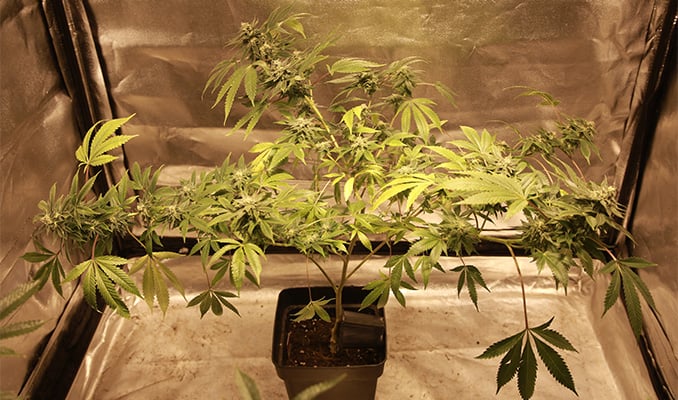Defoliation: A Risky Method to Increase Yield
Published :
Jan 25, 2018
Categories :
Cannabis cultivation

Defoliation is considered by many cannabis growers as a risky strategy to boost yields. But there are just as many devoted leaf-stripping growers arguing the opposite. In this blog, we break down this controversial pruning practice.
BEGINNER GROWERS BEWARE, BUT DON’T BE SCARED
Defoliation is all about removing leaves from indoor cannabis plants to increase yields. The beginner grower needs to exercise caution when applying this pruning technique. Despite the heated debate between advocates and those averse to leaf stripping, there’s no good reason for newbies not to experiment with defoliation.
HOW TO DEFOLIATE
Whether you are pruning leaves or limbs from cannabis plants, it’s best to use sterile scissors that are comfortable to hold. Plucking leaves away by hand is messy and can often lead to accidentally tearing away layers of stem along with the leaf. The primary objective of defoliation is to allow more light penetration and promote bigger bud production. Shading fan leaves must be removed. Pruning the main stem and/or secondary shoots is not defoliation.
The rule of thumb when giving your plants a haircut is to start with the largest, fattest fan leaves, trimming away from the bottom up. It’s important to strategically remove leaves and not cut haphazardly. You must also limit yourself to stripping away no more than 10-20% of the plant's total leaves. It’s all too easy to get carried away and end up with bald plants. Excess leaf removal will stunt plants and inhibit photosynthesis.
WHEN TO DEFOLIATE
Defoliation is rarely applied as a standalone high-yield technique. Leaf pruning is usually combined with other pruning and training for yield methods such as topping, fimming, LST, manifolding, supercropping, and ScrOG. Growers using the ScrOG method will need to strip away all lower growth, both leaves and stems, beneath the screen.
Cannabis plants can essentially be defoliated as soon as they transition from the seedling to vegetative growth phase. However, novices are advised to allow plants at least 1-2 weeks of vegetative growth prior to dabbling with defoliation. Moreover, some strains are more sensitive to pruning than others, and will be stressed by leaf stripping. Monitor post-pruning behaviour closely. Recovery time of 3-7 days minimum before repeating defoliation is highly recommended to avoid stressing plants. Growers can also defoliate during the flowering phase, allowing more energy to be focussed on bud production, while limiting shade and excess humidity. However, it is important not to defoliate too late in the game.

ADVANTAGES OF DEFOLIATION
Obviously, the number one benefit of defoliation is the yield-boosting potential of this pruning technique for all kinds of cannabis from photoperiod to autoflowering varieties. It’s no secret that flowers which receive more light grow bigger and fatter than those shaded by leaves. Furthermore, removing leaves from the interior of bushy plants helps to prevent the threat of mould. Really leafy plants with dense interior foliage will produce popcorn buds at best. Worst case scenario, the colas and nugs that are dense will succumb to bud rot.
If you see water droplets forming on the surface of leaves, it’s a good time to think about doing some defoliation. Clearing out the lower to middle interior leaves is a great way to improve airflow.
DISADVANTAGES OF DEFOLIATION
Indoor cannabis plants benefit from defoliation for two reasons. The first is because they receive light from a stationary overhead source, and the second is because the environmental conditions are controlled by the grower, not Mother Nature. Outdoor cannabis plants really don’t benefit from defoliation as the opposite holds true for them. The sun traverses the sky, illuminating different portions of the plant from sunrise to sunset.
Outdoor growers don’t need to manipulate plants to grow in a flat structure as the sun is infinitely more powerful than any grow lamp, and is always moving. Stripping leaves from outdoor plants also makes them more vulnerable in drought conditions and removes natural barriers against pests.
Indoor growers can, and many unfortunately do, reduce yields by defoliating plants at the wrong time and/or to excess. Pruning seedlings is ill-advised and usually leads to dwarfed plants. Scalping mature plants is even worse, and instead of long-running colas, you’re more likely to see fewer flowers. Similarly, pruning sick, unhealthy plants at any stage of growth is more likely to stunt growth, rather than encourage dense flower formation.






































